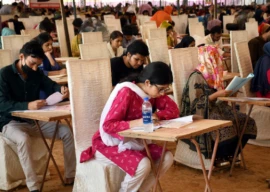
Pakistan’s dependent population – those under 14 and over 60 – is growing, which may contribute to its economic woes owing to the fact the country already has an inefficient, burgeoning labour force that is searching for jobs, as per the State Bank of Pakistan (SBP).
Behind Pakistan’s recurring macroeconomic imbalances are several structural challenges that constrain the country’s economic growth and development.
This was emphasised in the SBP’s Annual Report of 2021-2022, in a section entitled “The Promise of Pakistan’s Demographic Dividend?” These structural challenges include low levels of human development, lack of domestic savings and labour productivity.
“Underlying these challenges is rapid population growth that adds burden to the need for public and private infrastructure and government spending on public goods, while reinforcing poverty,” the report underlined.
Five decades ago, Pakistan ranked 10th among the world’s top 10 most populous countries, with a population of 59 million. In 2021, the country was ranked fifth, with a population of 231 million and a compound average growth rate of 3.1%.
In addition, between the period 1980-2000, the country’s population was the fastest growing among the top 10 countries on the list.
While the death rate has fallen over the years due to overall advancement in health care and improvement in living standards, the pace of decline in the birth rate has been slower. This translates into an increase in the total dependent population either in the form of child dependency (between ages of 0-14) or old-age dependency (ages greater than 65).
Due to this, among the most populous countries, Pakistan’s dependent population is the highest after Nigeria. “A closer look at Pakistan’s age structure reveals that the population has increased across all age groups over the last six decades, with the highest increase in the age cohorts of 0-14,” noted the SBP.
“This means that economic gains stemming from a growing working-age population are constrained by a large number of 0-14 dependents,” the report explained.
Accordingly, “Pakistan needs 45,000 training institutes and 200,000 technical and vocational education training (TVET) teachers, in addition to the existing system, to train an estimated youth cohort of about six million each year. Otherwise, unemployment would continue to escalate in the coming years,” as per the SBP report.
In contrast, slightly more than 0.4 million registered training seats are currently available in 3,740 training institutes, with the total staff strength of 18,207 trained teachers present in the formal TVET sector.
According to the Labour Force Survey (LFS), around 83% of the employed population has not received any sort of technical or vocational training. According to LFS 2021, about 27 million children between the ages of 5-14 were illiterate in 2021 and around 10 million children aged 10-14 had only primary education.
Unless these children are provided education later on in their lives, this illiterate and poorly trained cohort will account for an estimated 21% of the projected working-age population in 2031.
This would be in addition to 57 million people (or 33% of the projected working-age population) in 2031 who are either illiterate or who only have primary education, from the age cohorts that are already in the 2021 workforce and would still be within the working age in the next 10 years.
“These estimates necessitate a substantial increase in public expenditure on education, including technical and vocational training,” underscored the SBP report.
In comparison to the estimated need to spend 5.7% of GDP on education, actual spending on education in Pakistan has consistently remained below 2.5% of GDP.
Published in The Express Tribune, December 22nd, 2022.
Like Business on Facebook, follow @TribuneBiz on Twitter to stay informed and join in the conversation.



























COMMENTS
Comments are moderated and generally will be posted if they are on-topic and not abusive.
For more information, please see our Comments FAQ